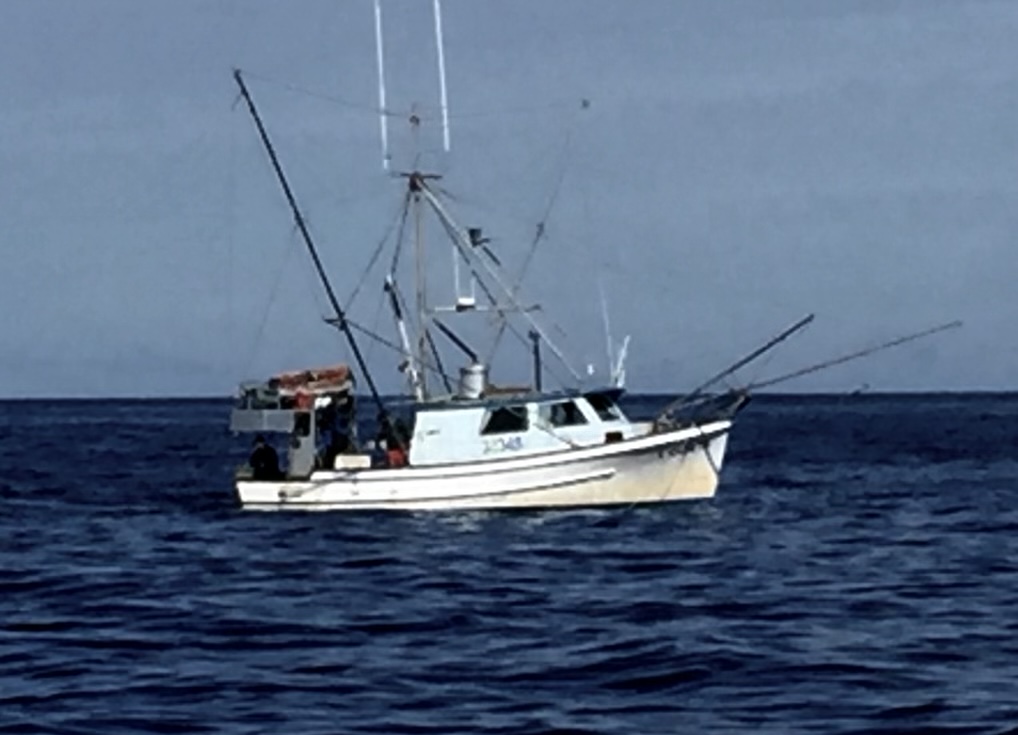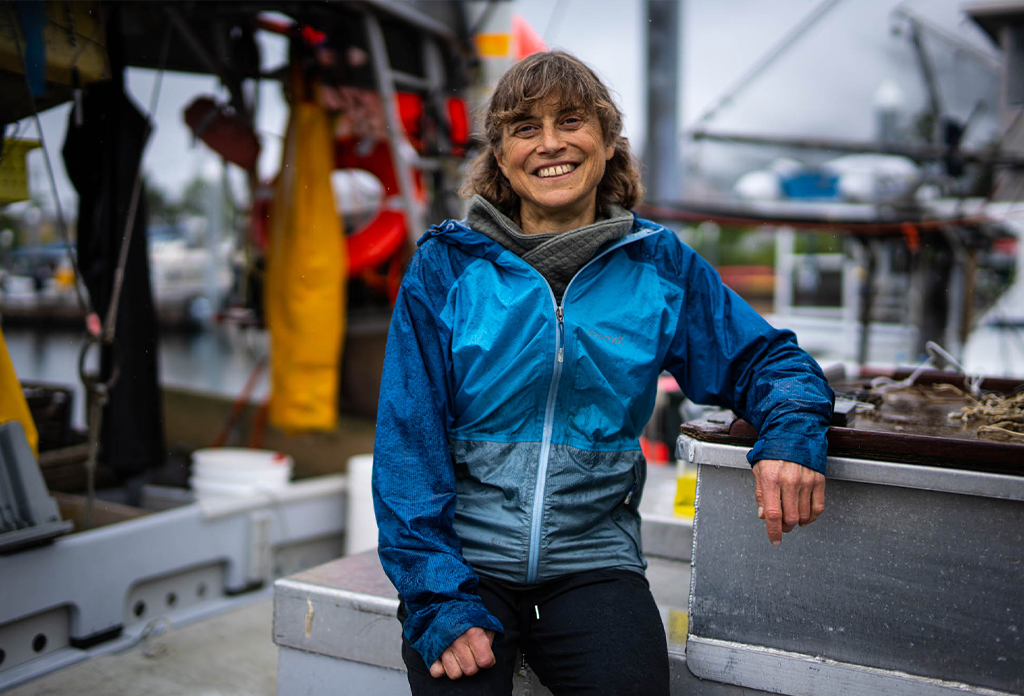Electric Vessel Update 2024
Imagine: You pilot your boat quietly into a secluded bay, savoring the perfect reflection of the shoreline mirrored in the still surface. The only sound is the swish of water along the hull. You step out onto the back deck and take a deep breath of clear crisp air—ahh, clean and quiet! Wait…no engine rumble echoing off the forested shore? No diesel fumes back-drafting into the cabin? Nope! Never again, thanks to the electric motor powering the vessel! You can also savor the minimal maintenance and inexpensive running cost of an electrically powered boat!

F/V I Gotta at sea (supplied by Eric Jordan)
“Marine ecosystems, which contain 90% of the global biosphere, are subjected to ever-increasing pressures from human activity. Marine transport, by unit, is one of the greatest contributors to the degradation of these ecosystems.” Quote from the website of Aqua superPower, a company specializing in marine electrical charging units: https://www.aqua-superpower.com/
The marine boat and power industry has amassed over 100 years of research and development into viable electric propulsion, from the tiniest of electric outboards on the stern of a dinghy, to the Yara Birkeland, the world’s first fully electric ocean-going container ship powered by massive battery banks. With the critical necessity of reducing our carbon emissions to net zero by 2050, the industry’s dedicated effort and ingenuity in developing cleaner power plants capable of greater and greater operating range are more welcome now than ever. Even so, progress has been slow, although Canadian company Vision Marine Technologies has recently introduced the E-Motion 180-E, an outboard capable of the power equivalent of a 180 hp internal combustion engine. Powering a sleekly designed racing hull, combined boat and motor set a world speed record for an electric boat of 116 mph.
Over 70 companies are currently competing in the marine electrical market with inboard and outboard motors, as well as integrated boat and motor models. Technological advances are improving propulsion speed and efficiency, producing smaller, lighter batteries and reducing costs. With increasing demand, further innovation and lower costs will prevail.
Base costs for electric outboards seem to be comparable to their gas-powered counterparts, but batteries and charging components add significantly to the total. The higher cost of purchase, however, is offset by lower and more stable recharging costs, minimal maintenance, zero toxic emissions and quiet operation. Lower operational costs can recoup added purchase expense quickly, especially for heavy users. Wholly electric inboard systems are increasingly available, as well as hybrid conversions. Contact the electric boat motor company of your choice for a quote—you could start with Elco, Mercury, and Yamaha, in the US. Yamaha has just acquired Torqeedo, the German electric outboard pioneer, who also has developed an inboard. Elco and ePropulsion will work with you on inboard packages. Plugboats.com offers comprehensive coverage of the latest technology, manufacturers, and dealers.
Charging Ahead
Battery charging, a crucial component of electric vessel operation, is actually less of a challenge than might be assumed. It’s usually as simple as plugging into the standard power pedestals found on our docks. A plug adapter or two may be needed depending on the voltage. As with electric cars, three levels of charging exist. Level one is accomplished by plugging into a 110V outlet. This low power input takes the longest, about 20 hours, to recharge a typical boat battery. Level 2 charging at 240V reduces charge time to 4-6 hours, substantially shorter. Level 1 and 2 charging can easily be done using the 30A or 50A outlets, respectively, which are commonly found in marinas. Level 3, or fast charge, can take as little as an hour, but does require a custom installation. Aqua superPower, a British company, specializes in marine electrical charging, and their chargers are now available in the US. Several marinas in Michigan, for example, with their vast access to freshwater boating, are very pleased with their Aqua superPower units.

Eric Jordan (supplied by Eric Jordan)
What about Southeast Alaska?
Fast charge units are, as yet, non-existent in Southeast Alaska harbors. That will likely change over the next few years as demand grows. The harbor department in Juneau, for instance, is beginning to consider such charging capacity for future upgrades. Sitka’s harbormaster is aware of federal funding for potential upgrades, but with no demand, as yet, from harbor users, dedicated dock chargers aren’t a priority. Fortunately, as mentioned above, the existing power capacity in Southeast Alaska harbors is perfectly suitable for most battery charging.
Sitka, Juneau, Petersburg, Wrangell and Ketchikan Harbormasters and personnel shared the above information in 2024.
Mirage? Or Crystal-clear Reality?
Regardless of marine electrical developments elsewhere, the Alaska Longline Fishermen’s Association, based in Sitka, is staying the course toward their goal of facilitating practical electrical power conversions of fishing vessels in their fleet. Like most cutting-edge endeavors, progress comes with interrupted momentum and course corrections. Their first conversion project, Eric Jordan’s troller, I Gotta, dropped out of the effort this past winter, short of completion. The reasons were several: Projects of this nature require long-term commitment as well as vessel suitability. What Eric believed to be a generous amount of engine-room space, or at least adequate, for the required electrical propulsion components and expanded battery storage, alongside his small existing diesel, ultimately proved a bit tight. Factoring in significant ongoing conversion expenses, installation challenges and his nearness to retirement, the investment became less justifiable. One other important factor is that while most fishermen are adept at troubleshooting and solving their own mechanical issues, understanding and maintaining electrical drive systems requires a different set of skills and knowledge, which, Eric admits, is a whole other learning curve. His decision to step back opened the door for another boat to benefit from the available grant funding procured by ALFA. Jeff Turner and his vessel Mirage are carrying the project forward. Jeff is already familiar with aspects of electric power systems, having begun some conversion on his own. He is committed to fishing for the foreseeable future, and fishes year-round, which will maximize diesel emissions savings.
Beyond ALFA’s goal of undertaking two vessel hybrid conversions, and implementation of a wholly electric mariculture boat (funded by an earlier Dept. of Energy award of $700,000) is, among other things, the funding of the Boat Energy Transition Accelerator Feasibility Study, (ALFA BETA). The study will focus on determining decarbonization and clean energy transition options for fishing and shoreside businesses alike. This study has now been funded through a federal grant of 514,000 to ALFA, made possible, at least in part, by support from Alaska Senator, Lisa Murkowski. https://www.alfafish.org/news-1/2024/3/21/murkowski-announces-investments-for-sitka-in-fy24-six-bill-appropriations-package

Linda Behnken
The ALFA BETA Project
The ALFA Beta decarbonization project aims to develop a transferable model that can be shared across Alaska as well as in Southeast, where two to five communities will be invited to participate. Communities will include at least one with more than 400 fishing vessels, like Sitka, and one with fewer than 100, like Hoonah or Yakutat. The project will offer energy audits to help vessel owners and shoreside businesses identify opportunities for energy efficiency and clean energy transitions. A planned gear innovation and training center in Sitka will involve the industry in next-generation design to spur transition.
A statement from ALFA articulated their vision, “By creating pathways to introduce energy efficiency, alternative fuels, and distribute renewable energy into ports and vessels that comprise Southeast Alaska’s seafood industry, the project will also create opportunities for entrepreneurs in energy-related fields such as engine suppliers and mechanics, marine engineers, HVAC installers, clean fuels engineers, and clean energy consultants.”
“These reductions [in greenhouse gas emissions] will contribute to industry and environmental health while reducing costs. In sum, rising fuel prices and climate-driven fishery collapses underline the urgency of decarbonizing the seafood industry, while innovations in renewable energy technology create the opportunities and solutions.”
Sources for the Sitka Electric Vessel section are from conversations with Eric Jordan and Linda Behnken and from an article summarizing the ALFA BETA project, written by Shannon Haugland and published in the Daily Sitka Sentinel, March 22, 2024. Direct quotes re: ALFA BETA are taken from the Sentinel Article.
~ by Barbara Bingham
